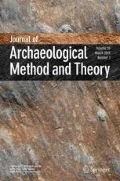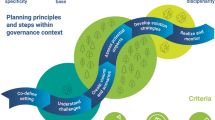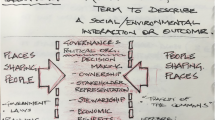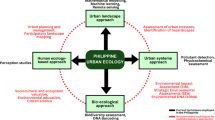Abstract
That despite over a decade and a half of research, effective dialogue within archaeology between Geographic Information System (GIS) (on one hand) and experiential theory (on the other) remains elusive is nothing short of remarkable. The present discussion seeks to not only explore the reasons behind this impasse but to suggest that perhaps the time for dialogue has passed and rather than building bridges, researchers in archaeological GIS should instead begin to build their own theoretical frameworks. To this end, a discussion of affordance (and its potential application in the field of experiential analysis) is offered.
Similar content being viewed by others
References
Aldenderfer, M., & Maschner, H. D. G. (Eds.). (1996). Anthropology, space and geographic information systems. New York: OUP.
Barrett, J. C., & Ko, I. (2009). A phenomenology of landscape: a crisis in British landscape archaeology? Journal of Social Archaeology, 9(3), 275–294.
Bender, B. (Ed.). (1993). Landscape: politics and perspectives. Oxford: Berg.
Brück, J. (2005). Experiencing the past? The development of a phenomenological archaeology in British prehistory. Archaeological Dialogues, 12(1), 45–72.
Chadwick, A. (2004). ‘Geographies of sentience’—an introduction to space, place and time. In A. Chadwick (Ed.), Stories from the landscape: archaeologies of inhabitation (pp. 1–32). Oxford: British Archaeological Reports. Int. Ser. 1238.
Chemero, A. (2003). An outline of a theory of affordances. Ecological Psychology, 15(2), 181–195.
Cummings, V. (2008). Virtual reality, visual envelopes, and characterizing landscape. In B. David & J. Thomas (Eds.), Handbook of landscape archaeology (pp. 285–290). California: Left Coast Press.
Fleming, A. (1999). Phenomenology and the megaliths of Wales: a dreaming too far? Oxford Journal of Archaeology, 18, 119–125.
Frieman, C., & Gillings, M. (2007). Seeing is perceiving? World Archaeology, 39(1), 4–16.
Gaffney, V., & van Leusen, M. (1995). Postscript: GIS, environmental determinism and archaeology. In G. Lock & Z. Stančič (Eds.), Archaeology and geographic information systems: a European perspective (pp. 367–382). London: Taylor & Francis.
Gaffney, V., Stančič, Z., & Watson, H. (1996). Moving from catchments to cognition: tentative steps towards a larger archaeological context for GIS. In M. Aldenderfer & H. Maschner (Eds.), Anthropology, space and geographic information systems (pp. 132–154). New York: OUP.
Gibson, J. J. (1979). The ecological approach to visual perception. New York: Psychology Press.
Gillings, M. (1998). Embracing uncertainty and challenging dualism in the GIS-based study of a palaeo-flood plain. European Journal of Archaeology, 1(1), 117–144.
Gillings, M. (2000). The utility of the GIS approach in the collection, management, storage and analysis of surface survey data. In J. Bintliff, M. Kuna, & N. Venclova (Eds.), The future of surface artefact survey in Europe (pp. 105–120). Sheffield: SAP.
Gillings, M. (2008). The Ecsegfalva landscape: affordance and inhabitation. In A. Whittle (Ed.), The early Neolithic on the Great Hungarian Plain: investigations of the Körös culture site of Ecsegfalva 23, Co. Békés (pp. 31–46). Budapest: Varia Archaeologia Hungarica.
Gillings, M. (2009). Visual affordance, landscape and the megaliths of Alderney. Oxford Journal of Archaeology, 28(4), 335–356.
Gillings, M. (2011). Chorography, phenomenology and the antiquarian tradition. Cambridge Archaeological Journal, 21(1), 53–64.
Greeno, J. G. (1994). Gibson’s affordances. Psychological Review, 101(2), 336–342.
Hammond, M. (2010). What is an affordance and can it help us understand the use of ICT in education? Education and Information Technologies, 15, 205–217.
Hodder, I. (2011). Human-thing entanglement: towards an integrated archaeological perspective. The Journal of the Royal Anthropological Institute, 17, 154–177.
Hopkinson, T. (2007). The middle Palaeolithic leaf points of Europe. Oxford: British Archaeological Reports. BAR Int. Ser.
Hunt, E. D. (1992). Upgrading site catchment analyses with the use of GIS: investigating the settlement patterns of horticulturalists. World Archaeology, 24(2), 283–309.
Hutchby, I. (2001). Technologies, texts and affordances. Sociology, 35(2), 441–456.
Ingold, T. (1992). Culture and the perception of the environment. In E. Croll & D. Parkin (Eds.), Bush base, forest farm (pp. 39–56). London: Routledge.
Ingold, T. (2005). Comments on Christopher Tilley: the materiality of stone: explorations in landscape phenomenology. Norwegian Archaeological Review, 38(2), 122–129.
Johnson, M. (2006). On the nature of theoretical archaeology and archaeological theory. Archaeological Dialogues, 13(2), 117–132.
Jones, K. S. (2003). What is an affordance? Ecological Psychology, 15(2), 107–114.
Judge, W. J., & Sebastian, L. (Eds.). (1988). Quantifying the present and predicting the past: theory, method and application of archaeological predictive modelling. Denver: US Department of the Interior.
Knappett, C. (2005). Thinking through material culture: an interdisciplinary perspective (archaeology, culture, and society). Philadelphia: UPP.
Lake, M. (2007). Viewing space. World Archaeology, 39(1), 1–3.
Llobera, M. (1996). Exploring the topography of mind: GIS, social space and archaeology. Antiquity, 70, 612–622.
Lock, G., & Stančič, Z. (Eds.). (1995). Archaeology and geographic information systems: a European perspective. London: Taylor & Francis.
McGrenere, J., & Ho, W. (2000). Affordances: clarifying and evolving a concept. Proc Graph Interface, 2000, 179–186.
Norman, D. A. (1988). The psychology of everyday things. New York: Basic Books.
Sadler, E., & Given, L. M. (2007). Affordance theory: a framework for graduate students’ information behaviour. Journal of Documentation, 63(1), 115–141.
Sturt, F. (2006). Local knowledge is required: a rythmanalytical approach to the late Mesolithic and early Neolithic of the East Anglian Fenland, UK. Journal of Maritime Archaeology, 1, 119–139.
Thomas, J. (2004). Archaeology and modernity. London: Routledge.
Thomas, J. (2008). Archaeology, landscape, and dwelling. In B. David & J. Thomas (Eds.), Handbook of landscape archaeology (pp. 300–306). California: Left Coast Press.
Tilley, C. (1994). A phenomenology of landscape. Oxford: Berg.
Tilley, C. (2004). The materiality of stone. Oxford: Berg.
Turvey, M. T. (1992). Affordances and prospective control: an outline of the ontology. Ecological Psychology, 4(3), 173–187.
Ullah, I. (2011). A GIS method for assessing the zone of human-environmental impact around archaeological sites. Journal of Archaeological Science, 38, 623–632.
Wansleeben, M., & Verhart, L. (1997). Geographical information systems: methodological progress and theoretical decline? Archaeological Dialogues, 4(1), 53–70.
Webster, D. S. (1999). The concept of affordance and GIS: a note on Llobera (1996). Antiquity, 73, 915–917.
Wickstead, H. (2009). The uber archaeologist: GIS and the male gaze revisited. Journal of Social Archaeology, 9(2), 249–271.
Acknowledgments
I would like to thank Jeremy Taylor for his insightful feedback on an earlier draft of this paper and the anonymous reviewers for their thoughtful and constructive comments.
Author information
Authors and Affiliations
Corresponding author
Rights and permissions
About this article
Cite this article
Gillings, M. Landscape Phenomenology, GIS and the Role of Affordance. J Archaeol Method Theory 19, 601–611 (2012). https://doi.org/10.1007/s10816-012-9137-4
Published:
Issue Date:
DOI: https://doi.org/10.1007/s10816-012-9137-4




